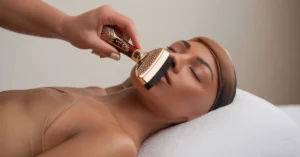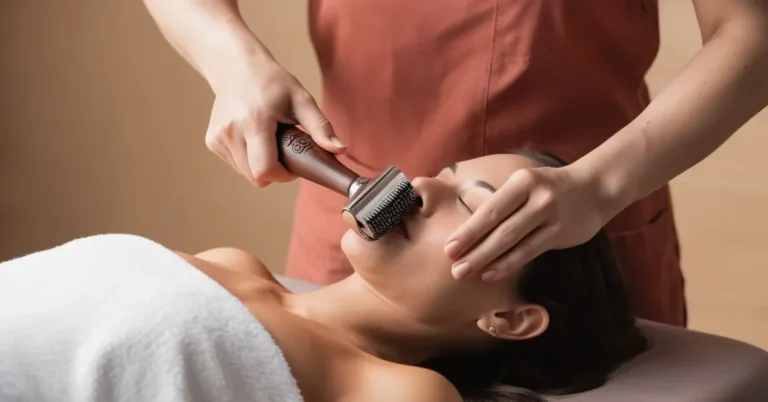GuaSha Tool, a traditional Chinese healing practice, has captured global attention in recent years. Though ancient in origin, it has found a place in modern wellness routines, touted for its purported health benefits ranging from pain relief to improved circulation. This article delves into the history, techniques, benefits, and controversies surrounding Gua Sha, offering a comprehensive exploration of why this practice has endured for centuries and why it continues to be relevant today.
The Origins of Gua Sha
Gua Sha has its roots in traditional Chinese medicine (TCM), dating back over 2,000 years. The term “Gua” means to scrape or rub, and “Sha” refers to the red, raised rash that typically appears after the treatment. The practice is based on the principles of TCM, which views health as a balance of the body’s vital energy, or “qi,” flowing through pathways called meridians. When qi becomes blocked or stagnant, it is believed to cause pain, tension, and illness. Gua Sha is employed to unblock this energy, promoting healing and restoring balance.
Historically, Gua Sha was used as a folk remedy, practiced by families and passed down through generations. It was commonly used to treat ailments such as colds, fevers, chronic pain, and respiratory issues. In rural areas of China, it was often the first line of defense against illness, owing to its simplicity and effectiveness. Practitioners used tools readily available at home, such as spoons, coins, or even animal bones, to perform the technique.
The Technique of Gua Sha

The practice of Gua Sha involves scraping the skin with a smooth-edged tool, typically made of jade, horn, or porcelain. The practitioner applies oil or a balm to the skin to reduce friction, then uses the tool to apply pressured strokes along the body’s meridians. The strokes are usually firm and repeated until red or purple marks, known as petechiae, appear on the skin. These marks, though sometimes alarming to those unfamiliar with the practice, are considered a sign that the treatment is working to release stagnant qi and toxins.
Gua Sha can be performed on various parts of the body, with the back, neck, shoulders, and limbs being the most common areas of treatment. The duration and intensity of the session vary depending on the individual’s needs and the practitioner’s assessment. While the appearance of the petechiae might suggest that Gua Sha is painful, most recipients describe the sensation as deeply therapeutic, akin to a deep tissue massage.
Modern Applications of Gua Sha
In recent years, Gua Sha has transcended its traditional roots to become a popular wellness practice worldwide. It has been embraced by both alternative and mainstream medicine, with practitioners extolling its benefits for a wide range of conditions. Some of the most common modern applications of Gua Sha include:
1. Pain Relief
One of the most widely recognized benefits of Gua Sha is its ability to alleviate pain, particularly in the musculoskeletal system. Studies have shown that Gua Sha can be effective in reducing chronic pain associated with conditions such as arthritis, fibromyalgia, and back pain. The scraping action of the tool is believed to stimulate microcirculation and reduce inflammation, providing relief from stiffness and discomfort.
2. Migraine and Headache Relief
Gua Sha has been employed as a remedy for migraines and headaches, offering an alternative to pharmaceutical treatments. By applying the technique to the neck and shoulders, practitioners aim to relieve tension and improve blood flow to the head, thus reducing the frequency and intensity of headaches.
3. Immune System Support
Proponents of Gua Sha suggest that it can boost the immune system by promoting lymphatic drainage and increasing circulation. This is particularly beneficial during the cold and flu season, as it is thought to help the body eliminate toxins and fight off infections more effectively.
4. Skin Health and Beauty
In the realm of skincare, Gua Sha has gained popularity as a natural method to enhance facial appearance. Facial Gua Sha involves using a smaller, gentler tool to massage the face, promoting lymphatic drainage and reducing puffiness. The technique is also said to stimulate collagen production, improve skin elasticity, and reduce the appearance of fine lines and wrinkles. Beauty enthusiasts have embraced facial Gua Sha as a non-invasive, holistic approach to skincare.
5. Stress Reduction
The repetitive, rhythmic strokes of Gua Sha have a calming effect on the nervous system, making it an effective treatment for stress and anxiety. By releasing tension and promoting relaxation, Gua Sha can help individuals manage the physical and emotional symptoms of stress, leading to a greater sense of well-being.
Scientific Evidence and Skepticism
While Gua Sha has a long history of use in traditional medicine, its integration into modern healthcare has been met with both enthusiasm and skepticism. Scientific studies on Gua Sha are still relatively limited, but emerging research supports some of the practice’s claims.
For instance, a 2011 study published in the journal Pain Medicine found that Gua Sha significantly reduced pain in patients with chronic neck pain. Another study, published in Complementary Therapies in Medicine in 2017, suggested that Gua Sha could be effective in alleviating symptoms of perimenopausal syndrome, including fatigue and insomnia.
Despite these positive findings, some medical professionals remain cautious, arguing that more rigorous, large-scale studies are needed to conclusively prove Gua Sha’s efficacy. Critics also point to the potential for bruising and skin irritation, particularly when the technique is performed incorrectly or with excessive force. However, proponents argue that these side effects are minimal and temporary, especially when compared to the benefits.
Gua Sha in Popular Culture
The rise of social media and wellness trends has played a significant role in the resurgence of Gua Sha. Influencers and celebrities have showcased their Gua Sha routines on platforms like Instagram and YouTube, contributing to its popularity among a younger, health-conscious demographic. Beauty brands have also capitalized on the trend, offering Gua Sha tools in various materials, shapes, and sizes, often marketed as essential components of a modern skincare routine.
This mainstream visibility has introduced Gua Sha to audiences who might otherwise be unfamiliar with traditional Chinese medicine, sparking interest and curiosity. However, it has also led to the commercialization of the practice, with some purists concerned that the essence of Gua Sha is being diluted or misrepresented in the pursuit of profit.
The Cultural Significance of Gua Sha
Beyond its physical benefits, Gua Sha holds cultural significance, particularly in its country of origin. In China, Gua Sha is more than just a healing technique; it is a symbol of familial care and community. The practice is often performed by family members for one another, serving as a gesture of love and concern. This communal aspect of Gua Sha reinforces the idea that health is not just an individual pursuit but a collective responsibility.
In this context, the global spread of Gua Sha can be seen as a form of cultural exchange, bringing traditional practices to new audiences. However, it also raises questions about cultural appropriation and the respect for the origins and meanings of these practices. As Gua Sha becomes more widespread, it is important to acknowledge and honor its roots in Chinese culture.
How to Practice Gua Sha at Home
For those interested in incorporating Gua Sha into their wellness routine, it is essential to approach the practice with knowledge and care. While Gua Sha is generally safe when performed correctly, improper technique can lead to bruising, skin damage, or other adverse effects. Here are some tips for practicing Gua Sha at home:
1. Choose the Right Tool
Selecting a suitable Gua Sha tool is the first step. Tools made from jade, rose quartz, or stainless steel are popular choices, each offering a different weight and texture. The tool should have smooth edges and fit comfortably in your hand.
2. Prepare Your Skin
Before starting, cleanse your skin thoroughly and apply a facial oil or moisturizer to reduce friction. This will allow the tool to glide smoothly over your skin and prevent irritation.
3. Learn the Technique
Familiarize yourself with the basic strokes and areas of the body suitable for Gua Sha. For facial Gua Sha, use gentle, upward strokes, starting from the center of the face and moving outward. For body Gua Sha, apply more pressure, but always listen to your body’s signals and avoid areas that feel overly tender or painful.
4. Be Consistent
Like any wellness practice, consistency is key to achieving the desired results. Incorporate Gua Sha into your routine regularly, whether it’s a few times a week or as needed.
5. Know When to Seek Professional Help
While at-home Gua Sha can be effective for general wellness, more serious conditions may require the expertise of a trained practitioner. If you are dealing with chronic pain or a specific health issue, consult with a healthcare provider before attempting Gua Sha on your own.
The Future of Gua Sha
As Gua Sha continues to gain popularity, its future seems bright. The practice is poised to remain a staple in both traditional and modern wellness circles, thanks to its versatility and effectiveness. Moreover, as research into Gua Sha and other TCM practices expands, we may see greater integration of these ancient techniques into mainstream healthcare.
However, the future of Gua Sha also depends on how it is practiced and understood. As the global wellness community embraces Gua Sha, there is a responsibility to preserve the authenticity of the practice and respect its cultural heritage. This means not only using the technique correctly but also appreciating the broader context of traditional Chinese medicine and the philosophies that underpin it.
Conclusion
GuaSha Tool is a time-honored healing technique that has found a place in modern wellness practices. Its ability to alleviate pain, improve circulation, and enhance skin health has made it a popular choice for those seeking natural, non-invasive treatments. While the practice is steeped in tradition, its recent resurgence in popularity is a testament to its enduring appeal and effectiveness.
As with any healing practice, it is important to approach Gua Sha with an open mind and a healthy dose of caution. Whether used as part of a professional treatment or an at-home self-care routine, Gua Sha offers a unique blend of ancient wisdom and modern benefits that continue to captivate people around the world.
In the evolving landscape of health and wellness, Gua Sha stands out as a powerful tool for promoting balance, relaxation, and overall well-being. Whether you are a seasoned practitioner or a curious beginner, exploring the art of Gua Sha can provide a deeper understanding of the body’s natural healing abilities and offer a pathway to improved health and vitality.

